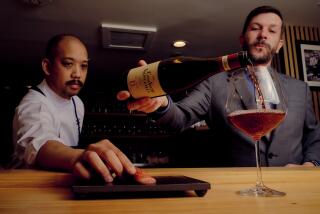Light and Inexpensive in Most Popular Form : Shochu: Drink of Japan’s Poor Is Now ‘In’
- Share via
TOKYO — A colorless concoction once derided as lower class swill is toppling traditional tipples as Japanese drinkers join the worldwide trend to light alcoholic beverages.
The beverage is shochu, a distilled spirit that in its most popular form resembles vodka. Once considered fit only for manual laborers, shochu sales are booming, increasing an average of 15% a year.
Sales of sake, a potent rice brew and Japan’s best known alcoholic drink, are declining by about 2% a year. Whiskey sales, which peaked in 1980, have been flat in recent years.
Shochu sales by volume overtook domestic whiskey in 1983 and industry observers say the Japanese are joining Western drinkers in moving away from two- fisted, calorie-laden darker spirits into the light world of white wines and “white” alcoholic beverages like vodka.
“It’s a tasteful white spirit,” said Toru Kumagai, an official with Kikkoman, Inc., a major shochu producer. “These days transparent drinks are preferred by Japanese consumers because of their healthy image.
“It’s popular among both the younger and older generations and we assume this demand will remain strong,” Kumagai said.
Kumagai said his firm was shifting workers from sake to shochu production.
There are two types of shochu. Type A, about 50 proof, is a colorless, tasteless, odorless distilled grain alcohol diluted with water and very similar to vodka. Type B is more traditional and distilled from rice, barley or sweet potatoes, or even sesame, black sugar or chestnuts and ranges from 40 to 72 proof.
Type A is very popular with young people who mix it with fruit juices, liqueurs and other liquids. It’s considered stylish and the color combinations appeal to the Japanese aesthetic sense that holds consumables should appeal to the eye as well as the palate.
Japanese distillers began marketing Type A in 1910 in an effort to utilize the excess alcohol produced by the introduction into Japan of Western distilling methods. For years it was a low-image mainstay of workingmen’s bars. Type B holds more appeal to middle-aged and older drinkers, although it’s very popular in many of the tiny neighborhood clubs that dot Japan. The most popular way to drink Type B shochu in the winter is in a tall glass with hot water.
It dates from medieval times and sometimes is made from the dregs left from sake brewing. Many regions in southern Japan have their own distinctive shochu distillation method and true shochu connoisseurs can spend whole evenings comparing the merits of spirits from different areas.
A kind of shochu made from black sugar is the favorite drink of Japan’s oldest man, Shigechiyo Izumi, 118, of Asan, about 820 miles southwest of Tokyo.
Izumi, whose age has been authenticated by the Guinness Book of WorldRecords, drinks half a pint of shochu every day, according to reports.
Shochu is not only trendy, it’s a lot cheaper because it is lightly taxed.
The tax rate on top drawer whiskey is 50.3% of retail value. Top grade sake nets 40.1% for the tax man, while beer brings in 48.8%. Type A shochu, however, is taxed only 14.4% and Type B at 8.7%.
That makes for a hefty price differential. Based on figures from the Japanese National Tax Administration Agency, a liter of domestically produced top quality whiskey is about $15.80 and a liter of good sake about $2.60.
But the best quality shochu costs only about $2.l5 a liter.
Imported whiskies and distilled wines cost from $30 to several hundred dollars in Japan and are usually purchased as prestige gifts.
Officials at Suntory, Japan’s largest whiskey producer, think the tax differential is unfair since, as one executive said, “so much of the consumer price is tax.”
The executive said the trend toward light drinks has cut into Suntory’s whiskey sales.
More to Read
Eat your way across L.A.
Get our weekly Tasting Notes newsletter for reviews, news and more.
You may occasionally receive promotional content from the Los Angeles Times.










